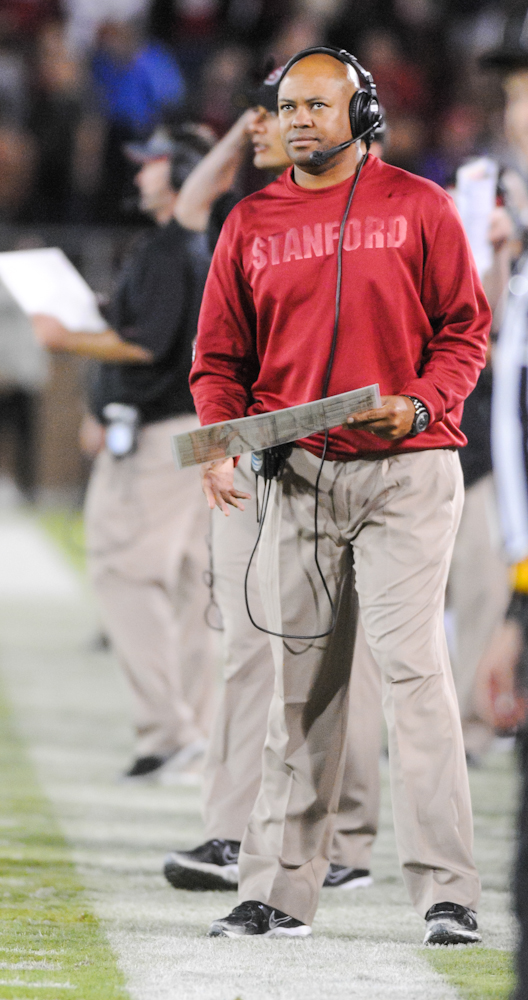It’s the elephant in the film room of Stanford’s opponents — a formation so big and heavy that offensive coordinator Mike Bloomgren can almost feel the ground shake when he sends it out onto the field.
Few short-yardage formations in college football are as intimidating as the Cardinal’s 3,200-pound behemoth. As if the seven offensive linemen at the line of scrimmage aren’t enough for a defense to handle, there’s two more 300-pounders in the backfield as well, forming a triangle with the running back.

“When you’ve got a guy like Josh Garnett or Johnny Caspers in the backfield and they’re coming downhill, there’s certain rules of physics that apply,” Bloomgren said of the two sophomore guards. “An object in motion tends to stay in motion. We believe in that fully.”
With the elephant formation in hand for short-yardage situations, it’s no surprise that Stanford’s third-down conversion percentage of .610 is fifth best in the nation. Believe it or not, though, the Cardinal has rarely gone for it on fourth down this season. Stanford has made it to fourth down 15 times in three games, and the offense has only lined up for a conversion twice, both on fourth-and-1. One of those plays resulted in a garbage-time incompletion; the other one ended in a defensive substitution penalty.
In several cases, the Cardinal has passed up a fourth-down conversion opportunity that, mathematically, would be a better choice than kicking a field goal or punting it away. There is statistical evidence to suggest that a football team should go for it, say, on fourth-and-8 from an opponent’s 36-yard line or on fourth-and goal from the 3 or 7 — three situations in which Stanford has already resorted to special teams this year.
It’s not that the Cardinal’s coaches are unaware of the data out there. The staff simply believes that there’s more to the equation.
“The role of statistics [for us] is what the defense is showing, what they’ve shown before,” Bloomgren said. “Are they a high-pressure team? Do we like the front? Do we feel like we’ve got great plays for said front? Where are we at? And do we like our matchups?…It’s not so much like the statistics of how many fourth-and-1’s are converted, or any of that stuff. It’s how we feel about us.”
That’s why former quarterback Andrew Luck ‘12, for example, got a longer leash on fourth downs when he was playing for the Cardinal.
As for Stanford’s opponents, the staff seeks the answers to those questions early in game week, during film study; the last thing the coaches want to do is to be caught off guard and let their emotions take over during a game. But there’s still some work to be done on Saturdays.
As a potential fourth-down situation approaches on gameday, the discussion flows back and forth over the coaches’ radio headsets. According to head coach David Shaw, the two main factors being evaluated by the staff are field position and momentum.
“Are we in good field position to where, with our defense, we feel good about — if we don’t make it — being where we are?” Shaw explained. “And secondly, are we feeling good about the play? Are we feeling good about how we’re playing? Do we feel like we have some kind of an advantage, whether it’s personnel or schematic?”
Though the final decision is left up to Shaw, finding those advantages is a team effort. From his aerie in the press box, quarterbacks and wide receivers coach Mike Sanford advises Shaw on the passing game; tight ends coach Morgan Turner, also sitting up top, helps Bloomgren keep an eye on the running game.
“I think the biggest thing is making the decision that takes your own ego out of [it] and puts the football team’s best interest at hand,” Sanford said. “There’s some decision-makers that probably think, ‘Hey, I want to be known as the guy who’s a riverboat gambler.’ I think the biggest thing is just knowing the situation, knowing the emotions leading up to that exact down, and then making that decision [in] the best interest of your football team.”
So, even though the Cardinal takes a lot of pride in its strength upfront, it won’t be trotting out the Elephant every time fourth-and-short arrives. At least for the ground’s sake, maybe that’s for the best.
Sam Fisher contributed to this post.
Contact Joseph Beyda at jbeyda ‘at’ stanford.edu
